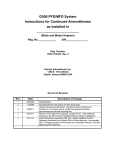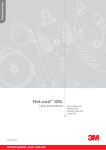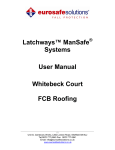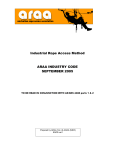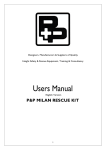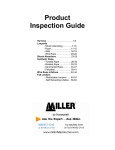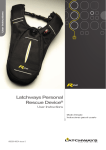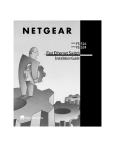Download PRD User Manual
Transcript
Personal Rescue Device™ User Instructions / Mode d’emploi 68220-96 Issue 1 Personal Rescue Device CA Introduction FR Introduction The user must read and understand this instruction manual before using this equipment. This manual must be kept in a safe place, along with the corresponding manual for the harness, for future reference with inspection records. L’utilisateur doit lire et doit comprendre ce manuel d’utilisation avant d’utiliser cet équipement. Ce manuel doit être gardé dans un lieu sûr, avec le manuel correspondant pour le harnais, pour la référence future avec les rapports d’inspection. This manual is written to comply with the requirements of CSA Z259.2.3-12 and ANSI Z359.4-2007, and should be used as part of an employee training program as required by OSHA. Ce manuel est écrit pour se conformer aux conditions de CSA Z259.2.3-12, et devrait être utilisé comme la partie d’un employé qui entraîne le programme comme exigé par OSHA. 2 Equipment Record / Registre de l’équipement R20 serial number Numéro de série R20 Signed / Signature Inspected by and on behalf of 3M. Inspecté par le compte et au nom de 3M. Date of purchase Date d’achat Supplied by Fourni par Date of first use Date de la première utilisation User name Nom de l’utilisateur Refer to harness user manual for harness inspection and equipment record 3M 4451 Raceway Dr, SW Concord, NC 28027 Tel (800) 560-1094 Fax (800) 560-1275 3 4 Date Date Pass/Fail Réussi / Échec Signature of Inspector Signature de l’inspecteur Next Inspection Prochaine inspection Periodic Examination Log / Journal de vérification périodique Comments/Actions Commentaires / actions 5 Date Date Comments/Actions Commentaires / actions Pass/Fail Réussi / Échec Signature of Inspector Signature de l’inspecteur Next Inspection Prochaine inspection CA Product markings FR Marquages du produit Descent device label / Étiquette du produit E AModel Modèle B Read the manual Lisez le mode d’emploi C Examination date Date de la vérification D Operating instructions Instructions d’utilisation F G H Operating temperature Température d’utilisation User weight Poids de l’utilisateur ATEX approval Approbation ATEX Applicable standards Normes applicables A Figure 1 / Figure 1 I J IManufacturer Fabricant J Serial number Numéro de série B H G C F E D J R20 07 2011 ?????? Model Date of manufacture Modèle Date de fabrication Refer to user instructions supplied with harness for label information / Se référer aux instructions d’utilisateur fournies avec le harnais pour les informations d’étiquette 6 Personal Rescue Device User Instruction Manual CA Content 1. Important information.............................................................................................................................................9 2. Terms and definitions..............................................................................................................................................9 3. Purpose..................................................................................................................................................................10 4. Limitations.............................................................................................................................................................10 5. System requirements............................................................................................................................................11 6. Inspection..............................................................................................................................................................12 7. Using the PRD........................................................................................................................................................13 1 Important information Before using this equipment, check that the Serial number of the descent device matches that listed on the equipment record sheet. The user must read, understand and follow this instruction manual before using this equipment. This manual must be kept in a safe place for future reference with inspection records and should be used as part of an employee training program. It is essential for the safety of the user that if the Personal Rescue Device (PRD) is resold outside the original country of destination the reseller shall provide instructions for use, maintenance, inspection, periodic examination and repair in the language of the country in which the device will be used. It is essential that users are competent in the use of the PRD. Users should have sufficient professional or technical training, knowledge and actual experience to enable them to: • carry out their assigned duties at the level of responsibility allocated to them; • understand fully any potential hazards related to the PRD; • detect any technical defects in the PRD, recognize any implications for health and safety from those defects, and be able to take remedial action to deal with these. The PRD shall only be used by a person who is trained and competent in its safe use. Contact 3M if you have any concerns regarding the use, maintenance, applications or operation of this device. Fitness and age significantly affect a person’s ability to safely withstand fall arrest loads. Only people who are physically and mentally fit and healthy, not under the influence of drugs or alcohol are permitted to use this equipment. If you are uncertain about your ability, consult your doctor. The PRD must not be used by pregnant women or minors. 2 Terms and definitions Personal Rescue Device (PRD): complete fall arrest body holding/rescue device made up of a full body harness, descent device and backpack . Descent/descender device: unit consisting of a fall arrest point, braking mechanism and descent line. Descent line: kernmantle rope contained within the descender device allowing the user to descend to a lower position. Load line: textile webbing contained within the descender device connecting the fall arrest point to the descent line. Release cord: webbing on shoulder strap which is pulled enabling mechanical release of the descent mechanism. 7 CA Personal Rescue Device User Instruction Manual Release pin: pin within the descent device that releases to initiate a descent. Backpack: textile bag attached to the harness containing the descender device. Anchor: fall arrest anchor device with a minimum capacity of 22.5 kN. 3 Purpose The PRD comprises a full body harness conforming to CSA Z259.10-06, CSA Z259.10-12 or ANSI Z359.1-2007 with integral descender device conforming to CSA Z259.2.3-12 (Type 1, Class D) and ANSI Z359.4-2007. The PRD is intended to be used in a fall arrest system and, in the event of a fall, the descent device can be activated by the user to lower the user safely to a lower level. Once activated, the descent speed is automatically limited and requires no further input from the user. The PRD should be a personal issue item. Descender model number Maximum descent height Descent energy Descent line type R20 (68210-00) 65 ft / 20 m 25,300 ft/lbF / 34,300 J 3/16” / 5.4 mm diameter Ultra-High Molecular Weight Polyethylene (UHMwPE) core, Aramid overbraid rope 4 Limitations The PRD shall not be used outside its limitations or for any purpose other than that for which it is intended. All inspections should be conducted by a competent person. Do not attempt to modify or repair the equipment. It is critical for your safety that these instructions are followed and the equipment is not misused. 1 Total user weight (including tools) 130 lbs min 310 lbs max (59 kg min – 140 kg max). Maximum user weight will also depend on the rated load of the harness. Refer to harness manual. 2 The PRD is for rescue purposes only, for a single descent only. 3 Only one person can be connected to the PRD at any time. 4Use of this equipment in hazardous environments may require additional precautions to reduce the possibility of injury to the user or damage to the equipment. Hazards may include, but are not limited to: high heat, fires, acids, caustic solutions, welding flames, explosive or toxic gases, corrosive environments, sharp edges, moving machinery. 5 Operating temperature -4°F to +140°F (-20°C to +60°C). 6 Descent speed is between 1.6 – 6.6 ft/sec (0.5 – 2 m/sec). 7 After a single descent, the descender device shall be withdrawn from service, details recorded on the periodic examination log and referred to 3M. 8 Should a fall occur and the fall arrest harness be subject to fall arrest loads, it must be withdrawn from service, details recorded on the periodic examination log and referred to 3M. 9 The life of the product can be affected by environmental conditions. 10The PRD is suitable for use in areas in which explosive atmospheres caused by mixtures of air and gases, vapours or mists or by air/dusts mixtures are likely to occur, as per BS EN 13463-1:2001 equipment group II, category 2. II 2 G c IIC T3 8 Personal Rescue Device User Instruction Manual 5 System requirements CA Figure 2 5.1 Risk assessment and rescue planning The PRD forms part of a fall protection system and as such it is recommended that before undertaking work at height and at regular intervals during the period of work, a risk assessment should be carried out. The risk assessment should cover, but is not limited to, descent height, descent path, suitability of landing areas. In addition to the risk assessment ensure a rescue plan is in place to deal with any emergency that may arise and you are fully aware of the procedure before attempting to work at height. The PRD is designed primarily as a self-rescue system and will assist with rescue planning. However, in the event that the user is unable to initiate self-rescue a secondary release means is provided on the right-hand shoulder area. This takes the form of a red and black rubberised loop which can be pulled by a rescuer to activate the descent (See Figure 2). Secondary release by a rescuer should be taken into account in the risk assessment. 5.2 Unprotected edges It is good working practice to avoid allowing any parts of a fall arrest system (including the harness and lanyard) from contacting, or abrading against, unprotected edges. ✔ The risk assessment described in section 5.1 should identify appropriate precautions to be taken to avoid contact with unprotected edges or where use over an edge is possible, the risk assessment should identify appropriate precautions to be taken. 5.3 100% Connected elements 5.3.1 Anchor Only use the PRD with a suitable fall protection system (complying with appropriate CSA standards), connected back to a 100% anchorage connector and structure. Anchorage connectors and structure must be able to sustain a minimum load suitable of 22.5 kN (refer to CSA Z259.13 or CSA Z259.15) If more than one user is attached to the same anchor then the anchor should be capable of sustaining the loads arising from multiple falls. Before connecting to the anchor, consideration should be given to the descent path, refer to 7.4. 6 WARNING! It is essential for safety that the anchor device or anchor point should always be positioned and work carried out, in such a way as to minimize both the potential for falls and potential fall distance. It is also recommended that the anchor device/point is positioned above the position of the user. ✔ 300 kg 100% 5.3.2 Lanyard Always use an energy absorbing lanyard or retractable type fall arrestor that comply with relevant standards such as CSA Z259.2.2, CSA Z259.11, ANSI Z359.1, ANSI Z359.13 or ANSI Z359.14. 100% 6 5.3.3 Connectors Connectors must conform to CSA Z259.12, ANSI Z359.1 or ANSI Z359.12 and be securely locked to prevent opening. WARNING! Incompatible components can lead to connectors accidentally disengaging. 300 kg 9 CA Personal Rescue Device User Instruction Manual 5.3.4 Harness The PRD is intended to consist of a descent device and backpack combined with a compatible harness. Refer to harness manual for further information on usage and limitations. 5.3.5 Combinations ✔ The PRD may be used with combinations of fall arrest equipment. However, attention must be paid to the compatibility of such items, and considered as part of the risk assessment process - incompatible items (such as inappropriate connectors) may hinder the operation of fall arrest equipment to which they are attached, resulting in potential injury to the user. 100% 6 Inspection The PRD has been specifically designed as a user friendly device, incorporating a range of features to aid pre-use checks and on-site periodic examination, and wherever possible minimize the need to return the device to 3M or authorized agent. 100% 6 6.1 Pre-use checks These are the detailed descent device that should be carried out by the user before each use. • Thoroughly inspect all equipment and components before each use. • No repairs, modifications or alterations are to be carried out on the PRD. 300 kg Figure 3 6.1.1 Descent device/line • Inspect the D-ring connector for signs of damage, excessive wear, distortion, corrosion or cracking. • Ensure that the descent line is not paid out of the device, this would indicate that a descent has occurred (See Figure 3). If descent line is paid out do not use. Remove the PRD from service and refer to 3M or authorized agent. Figure 4 • Open the backpack containing the descent device (See Figure 4). • Inspect the general condition of the descent device for signs of damage or corrosion. If damage is apparent do not use. Remove the PRD from service and refer to 3M or authorized agent. Figure 5 • Inspect descent line for any ‘slack’ between the drum and rack (See Figure 5). If line shows any sign of slack—the PRD should be removed from service and refer to 3M or authorized agent. 10 Personal Rescue Device User Instruction Manual CA • Check the legibility of the product markings. Figure 6 • Inspect the release pin for signs of damage, distortion, corrosion or cracking. Ensure that it has not been disengaged. Ensure that the red release cord is positioned under the release pin and that the load-line webbing is looped around the release pin (See Figure 6). • Ensure that the green release pin clip is present and undamaged—check for signs of damage, distortion or cracking (See Figure 6). • Ensure that the release cord guide is undamaged (See Figure 7). Figure 7 • Inspect the descent line, load-line and release cord for signs of cuts, abrasion, fraying, tears, mold, discoloration, chemical attack or excessive build-up of dirt. Check the stitching for signs of loosening, pulling or cut thread. Excessive build-up of dirt may prevent the descent line from pulling through the device. If damage is apparent do not use. Remove the PRD from service and refer to 3M or authorized agent. • After inspection close the zip on the backpack fully. Figure 8 • Unzip the back panel of the backpack and inspect the harness connector for signs of damage, distortion, corrosion or cracking. Ensure that the fastening bolt is secure (See Figure 8). If damage is apparent do not use. Remove the PRD from service and refer to 3M or authorized agent. ✔ 100% • Inspect all system components and subsystems according to 3M instructions. ✔ 6.1.2 100% Harness 6 Refer100% to harness manual for instruction on inspecting and maintaining harness. Buckles must be free from rust, excessive wear, distortions or cracks. 100% 6 WARNING! Each harness is designed to arrest a fall from height only once. If subjected to an arrested fall the harness must be withdrawn from service and destroyed to ensure that it is not used again. 300 kg 300 kg WARNING! It is essential for safety that if any part of the PRD is found to be faulty, or you are in any doubt concerning the safety or condition of the PRD, it must be removed from service and refer to 3M or authorized agent. It may not be used again until confirmed in writing by a competent person that it is safe to do so. 11 CA Personal Rescue Device User Instruction Manual 6.2 Periodic examination These are the checks that should be carried out by a competent person other than the user. The PRD will be a key component in your emergency rescue plan and as such, periodic examination should be conducted at least once every 12 months; however, local, state, governmental and jurisdictional agencies may require more frequent or mandatory periodic examinations of which the user is required to comply. Additionally, environmental conditions may be such that more frequent periodic examinations may also be necessary. Refer to harness user information for further detail on examination of harness. The periodic examination should be recorded in the periodic examination log. A copy of the PRD Periodic Examination Guide is available to download from: www.3M.com The service life of the PRD, based upon its textile elements, has been evaluated to be up to 10 years. However, the following factors such as (but not limited to): environmental conditions (eg contact with chemicals, exposure to temperatures >140ºF (>60ºC)), incorrect storage, frequency of use, may reduce the service life. 6.3 Basic maintenance, storage and transportation ✔ If required, you may clean the PRD exterior of light soiling, with warm water 104ºF (40°C) with pure soap or mild detergent. Refer to harness manual for instruction on cleaning of harness. After cleaning, rinse thoroughly with fresh clean water then remove excess water with a dry cloth. Allow to dry naturally, away from direct heat, then examine fully before storing. Store in a cool, dry, clean environment. Ensure the PRD is protected from extreme humidity, dust, oil and direct sunlight. If the PRD 100%is wet, allow to dry naturally before storage. Inspect the PRD after long periods of storage. During transportation the device must be protected to prevent damage or contamination. It is recommended that, when subject to long periods of storage, the PRD is hung to reduce potential build up of moisture or other contaminants. 100% Lubrication of the equipment is not required and no maintenance, other than cleaning, should be undertaken. 6 This requires actions by the competent person that do not require parts to be replaced but will require the device to be temporarily removed from service e.g. cleaning. WARNING! The continued efficiency and durability of the PRD is dependent on regular periodic examinations. 300 kg 7 Using the PRD 7.1 Fitting and adjusting the harness It is critical for your safety that the harness is fitted correctly. The harness should be worn outside your clothing. Figure 9 Refer to harness user information for details on fitting and adjusting the harness. 12 Personal Rescue Device User Instruction Manual ✔ Figure 10 Note: If adjustment of the shoulder straps is required, remove the harness and undo the zips on either side of the backpack (See Figure 10). Adjust the shoulder straps by sliding the shoulder strap adjustment buckles and cross strap buckle (where the shoulder straps 100% cross). Check adjustment by continuing to try on the harness until the chest strap and connection point are correctly positioned. 100% EN516 Connect the karabiner of the energy absorbing lanyard to the fall arrest attachment point marked ‘A’ (See Figure 11). Figure 11 A CA 300 kg WARNING! Do not connect to any point of the harness or PRD other than those clearly marked as fall arrest attachments. The PRD rescue function will operate only on the rear D-ring (see figure 11 and section 7.2). 7.2 Additional fall arrest attachments ✔ Some harnesses include additional fall arrest attachments (e.g. at the chest or shoulders). Refer to harness user information for correct use of these attachments. However, the PRD rescue facility will operate on the rear attachment only. Where attachments other than the rear D ring are used, an alternative rescue plan must be in place before proceeding with work at height. 100% 7.3 Activating self rescue During a descent it may be possible to safely land on a lower part of a structure. This is not recommended. If attempted in an emergency situation it is important to avoid causing slack in the descent line and the 100% chance of a secondary fall. 6 7.4 Operating instructions WARNING! Before activating the PRD descender, ensure that the descent path is clear of obstructions and sharp edges that may contact the descent line during a descent. Only activate when it is safe to descend. 300 kg 13 CA Personal Rescue Device User Instruction Manual Figure 12 1 ✔ ✔ 2 1 Check the ground below to ensure 100% descent path is clear and a safe landing is possible. 3 2 Open the flap on the right shoulder strap to access the release cord. 3 Pull sharply on the release cord. 4 4 Prepare for landing by bending knees. 100% 100% 6 Following a descent, internal components of the PRD may become hot – do not open backpack immediately following operation. 100% 6 WARNING! After a descent, the PRD must be withdrawn from service, details recorded on the periodic examination log and referred to 3M or authorized agent. 300 kg 300 kg WARNING! If accidental activation of the PRD occurs, it must be withdrawn from service, details recorded on the periodic examination log and referred to 3M or authorized agent. Do not attempt to reset the release mechanism. If accidental activation goes unnoticed, when load is applied to the PRD (i.e. when used to restrain the user), the descent line will pay out causing an audible click to indicate that the release pin mechanism has been activated. 14 15 Personal Rescue Device 3M 4451 Raceway Dr, SW Concord, NC 28027 Tel (800) 560-1094 Fax (800) 560-1275 ™ Personal Rescue Device is a trademark of Latchways plc 68220-96 Issue 1 Personal Rescue Device 3M 4451 Raceway Dr, SW Concord, NC 28027 Tel (800) 560-1094 Fax (800) 560-1275 ™ Personal Rescue Device is a trademark of Latchways plc 68220-96_1 User instructions Personal Rescue Device™ User Instructions Mode d’emploi 68220-96 Issue 1 Personal Rescue Device



















